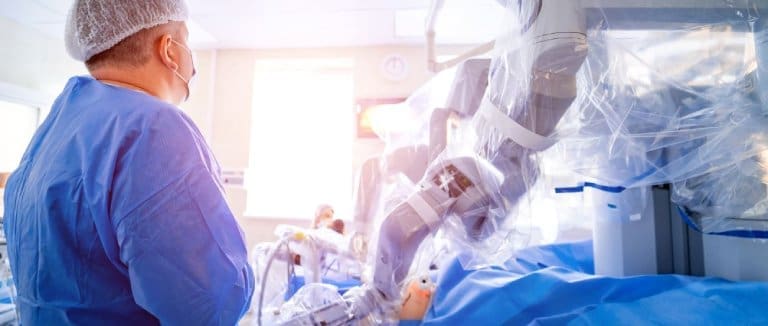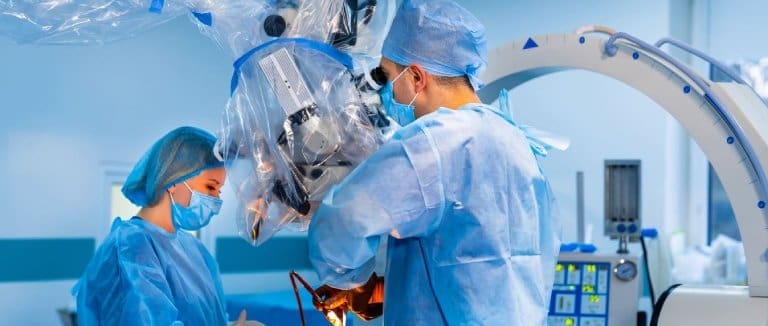Robotic Kidney Surgery: Precision, Innovation, and Recovery in Turkey
Robotic kidney surgery is one of the most advanced and effective surgical methods available in modern medicine. It combines the skill of experienced surgeons with the accuracy of robotic technology to treat kidney conditions such as tumors, obstructions, and kidney stones with minimal invasiveness. Turkey has become a leading destination for robotic kidney surgery, offering patients world-class medical expertise, modern facilities, and affordable treatment options. Among the top healthcare centers, Liv Hospital stands out for its excellence in robotic kidney surgery, providing state-of-the-art procedures and personalized patient care.

What is Robotic Kidney Surgery ?
Surgery is a minimally invasive surgical technique performed with the assistance of robotic systems, such as the da Vinci Surgical System. In this procedure, a surgeon controls robotic arms from a console, guiding them to perform delicate movements with exceptional precision. These robotic arms can rotate and maneuver beyond the natural range of human hands, allowing for greater accuracy and control.
The main advantage of robotic kidney surgery is that it enables surgeons to perform complex operations through small incisions, reducing trauma to surrounding tissues. The technology provides a 3D high-definition view of the surgical field, magnifying even the smallest anatomical details. This allows for precise dissection, suturing, and removal of diseased tissue while preserving as much healthy kidney function as possible.
Liv Hospital in Turkey uses advanced robotic systems to perform kidney surgeries for various conditions, including kidney cancer, ureteropelvic junction obstruction, and kidney stones.
Why Choose Robotic Kidney Surgery ?
Traditional open kidney surgery often requires large incisions and a long recovery period. In contrast, robotic kidney surgery minimizes pain, reduces scarring, and accelerates healing. Patients who undergo robotic procedures benefit from faster recovery, less postoperative discomfort, and improved cosmetic results.
The precision of robotic surgery ensures that healthy kidney tissue is preserved while the diseased or damaged part is carefully removed. This is particularly important for patients with tumors or partial kidney removal (partial nephrectomy), where maintaining kidney function is essential.
Liv Hospital offers a specialized robotic surgery program designed to deliver optimal outcomes for kidney-related procedures. The hospital’s team of urologists and robotic surgeons is internationally recognized for their expertise in performing robotic kidney surgery with high success rates.
Conditions Treated with Robotic Kidney Surgery
Robotic kidney surgery is used to treat a wide range of urological conditions, including:
• Kidney cancer (partial or total nephrectomy)
• Ureteropelvic junction obstruction (UPJ obstruction)
• Kidney cysts and benign tumors
• Complex kidney stones
• Ureteral strictures
• Reconstructive kidney surgery after injury or damage
The flexibility and precision of robotic systems make it possible to perform these procedures with minimal blood loss, reduced risk of complications, and shorter hospital stays.
Robotic Kidney Surgery for Kidney Cancer
One of the most common applications of robotic kidney surgery is the treatment of kidney cancer. In the case of partial nephrectomy, the surgeon removes only the cancerous portion of the kidney, preserving the healthy tissue. Robotic technology allows the surgeon to make precise cuts and stitches with minimal damage to surrounding structures.
At Liv Hospital, robotic partial nephrectomy is performed by highly skilled surgeons who use real-time imaging and advanced surgical techniques to ensure complete removal of cancerous tissue. Patients benefit from shorter recovery times, smaller scars, and reduced risk of postoperative complications.

Robotic Kidney Surgery for Kidney Stones in Turkey
Robotic surgery for kidney stones in Turkey has gained significant attention for its effectiveness and safety. While many kidney stones can be treated with non-surgical methods such as lithotripsy, larger or complex stones may require surgical removal. Robotic-assisted procedures provide surgeons with exceptional control and visibility, allowing them to remove stones precisely while minimizing damage to the kidney.
Liv Hospital offers robotic surgery for kidney stones as part of its advanced urology program. The hospital’s robotic systems allow surgeons to treat even the most complicated kidney stone cases with precision. Patients from around the world travel to Turkey, and especially to Liv Hospital, for robotic kidney surgery because of the combination of modern technology, expert care, and cost-effectiveness.
The benefits of robotic surgery for kidney stones include:
• Smaller incisions and minimal scarring
• Reduced pain after surgery
• Faster return to normal activities
• Lower risk of infection and bleeding
• Preservation of kidney function
With its state-of-the-art robotic technology, Liv Hospital continues to set new standards for the treatment of kidney stones and other kidney-related conditions.
The Procedure: How Robotic Kidney Surgery Works ?
During robotic kidney surgery, the patient is placed under general anesthesia. The surgeon makes small incisions in the abdomen to insert the robotic instruments and a camera. The robotic system then translates the surgeon’s hand movements from a console into precise actions inside the patient’s body.
The 3D high-definition view enables the surgeon to visualize the kidney’s structure in great detail. This enhanced visibility allows for better identification of blood vessels, nerves, and surrounding organs, minimizing the risk of injury. Once the procedure is complete, the instruments are removed, and the small incisions are closed.
At Liv Hospital, robotic kidney surgery procedures are performed in fully equipped operating rooms designed for advanced robotic-assisted operations. The hospital’s surgical teams undergo continuous training to stay updated on the latest robotic surgery techniques.
Advantages of Robotic Kidney Surgery
Robotic kidney surgery offers several advantages over traditional open or laparoscopic surgery:
• Greater precision and control
• Smaller incisions and reduced scarring
• Minimal blood loss and lower infection risk
• Shorter hospital stay
• Faster recovery and return to daily activities
• Reduced postoperative pain
• Preservation of healthy kidney tissue
These benefits make robotic kidney surgery an excellent option for patients seeking safer and more efficient surgical solutions. Liv Hospital emphasizes a patient-centered approach, ensuring that every individual receives comprehensive care before, during, and after surgery.
Robotic Kidney Surgery in Turkey: Why Patients Choose It ?
Turkey has become a global hub for robotic kidney surgery due to its advanced medical infrastructure, highly trained surgeons, and competitive pricing. Hospitals such as Liv Hospital offer robotic procedures at international standards while maintaining affordability compared to hospitals in Europe or the United States.
The country’s healthcare system prioritizes technological innovation and medical excellence, attracting thousands of international patients every year. At Liv Hospital, the focus is on delivering high-quality outcomes through modern robotic systems, skilled medical teams, and comprehensive patient care programs.
Robotic Kidney Surgery at Liv Hospital
Liv Hospital is one of Turkey’s leading healthcare institutions, offering advanced robotic kidney surgery performed by world-class urologists and robotic surgeons. The hospital combines innovative medical technology with a multidisciplinary approach to deliver the best possible results.
Liv Hospital’s robotic surgery department features advanced systems like the da Vinci Surgical System, which provides unparalleled precision and control. The hospital’s surgeons use this technology to perform complex procedures such as partial nephrectomy, reconstructive kidney surgery, and robotic surgery for kidney stones.
International patients choose Liv Hospital not only for its surgical expertise but also for its seamless healthcare experience. The hospital’s International Patient Services Department assists patients with travel arrangements, translations, and personalized medical coordination, ensuring comfort and convenience throughout the treatment process.
The Future of Robotic Kidney Surgery
As technology continues to evolve, robotic kidney surgery is expected to become even more efficient and accessible. Future developments may include artificial intelligence integration, enhanced robotic sensors, and improved imaging techniques for real-time surgical planning.
Liv Hospital remains at the forefront of this progress, continuously investing in research, technology, and surgeon training. By combining medical innovation with compassionate care, Liv Hospital ensures that patients benefit from the most advanced and effective kidney surgery methods available.
Conclusion
Robotic kidney surgery represents the future of urology and kidney care, offering unmatched precision, minimal invasiveness, and faster recovery times. Turkey has established itself as a leader in this field, providing world-class robotic kidney surgery at affordable costs.
Liv Hospital exemplifies excellence in robotic kidney surgery, combining advanced technology, expert surgeons, and a patient-centered approach. Whether it is robotic kidney surgery for cancer or robotic surgery for kidney stones in Turkey, patients can expect outstanding results and a superior recovery experience. Choosing Liv Hospital means choosing excellence, safety, and innovation in every aspect of kidney care.
* Liv Hospital Editorial Board has contributed to the publication of this content .
* Contents of this page is for informational purposes only. Please consult your doctor for diagnosis and treatment. The content of this page does not include information on medicinal health care at Liv Hospital .
For more information about our academic and training initiatives, visit Liv Hospital Academy
Frequently Asked Questions
What is robotic kidney surgery?
Robotic kidney surgery is a minimally invasive procedure using robotic systems like the da Vinci Surgical System to treat kidney conditions. The surgeon controls robotic arms through a console to perform precise movements, allowing smaller incisions, less pain, and faster recovery.
What conditions can robotic kidney surgery treat?
It can effectively treat kidney cancer, ureteropelvic junction obstruction, kidney cysts, complex stones, and other structural or functional kidney problems.
How does robotic kidney surgery work?
Small incisions are made in the abdomen to insert robotic instruments and a 3D camera. The surgeon operates from a console, and the system translates movements into highly precise surgical actions.
What are the benefits of robotic kidney surgery?
Patients experience smaller scars, reduced blood loss, minimal pain, lower infection risk, and quicker recovery. The precision of robotic systems helps preserve healthy kidney tissue.
Is robotic kidney surgery safe?
Yes. It is considered very safe when performed by trained surgeons. Advanced robotic systems allow maximum precision, minimizing risks of bleeding or tissue damage.
How long is recovery after robotic kidney surgery?
Most patients stay in the hospital for 1 to 3 days and return to normal activities within a few weeks, depending on the complexity of the procedure.
Why choose robotic kidney surgery over open surgery?
Robotic surgery involves smaller incisions, faster healing, and better cosmetic results compared to traditional open surgery, which typically requires a longer recovery period.
Why is Turkey a popular destination for robotic kidney surgery?
Turkey offers advanced technology, experienced surgeons, and affordable pricing compared to many Western countries. Hospitals like Liv Hospital meet international medical standards.
What makes Liv Hospital a leader in robotic kidney surgery?
Liv Hospital uses cutting-edge robotic systems, expert urologists, and personalized care programs to ensure safe, successful outcomes and comfortable recovery for local and international patients.
What is the future of robotic kidney surgery?
The future involves AI integration, enhanced robotic precision, and real-time imaging for even safer and more accurate operations. Liv Hospital continues to lead innovation in this field.

